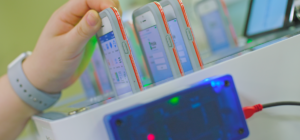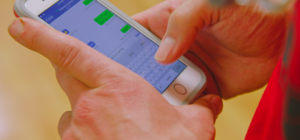Heart disease. Cancer. Medical errors. In that order, those are America’s leading causes of death, according to research from the Johns Hopkins University School of Medicine. While the medical community has invested time and clinical talent in reducing chronic disease, minimizing medical errors is just as important—but where do you start?
Defining the problem is as good a place as any: After all, the average layperson might imagine surgical hack jobs or incorrect diagnoses when they think of such errors, but in reality, research has pointed to daily communication breakdowns—like doctor-to-nurse interactions, or misunderstandings during the transfer of care—as a major contributor.
That’s why there’s a growing chorus of industry experts who point to big problems with medical miscommunication, specifically. For example, one study from CRICO Strategies found that communication mistakes led to more than 1,700 deaths and $1.7 billion in malpractice suits. All told, one in every three malpractice cases was caused by a communication error.
It’s a costly and preventable problem—not to mention one that’s downright heartbreaking for surviving friends and family. But with the right strategy that prioritizes accurate and efficient communication, a scalable clinical communication and collaboration solution can help. Consider, for example, these four communication traps prone to becoming medical errors:
1. Pre- and Post-Operative Coordination
When a care team makes a surgical error, it’s commonly before or after the surgery—rather than in the operating room. That’s why pre- and post-operative communication is critical.
The CRICO analysis provided an example of a patient who told a nurse about post-procedure pain. The nurse didn’t tell the surgeon, and the patient later died of internal bleeding. But if the nurse had access to a communication tool like MH-CURE®, they could have alerted the physician immediately by selecting the patient and relevant on-call providers from a drop-down menu. Pull out the phone, tap a message, select the provider and patient, and send.
2. Patient Transfer Handoffs
Up to 8 in 10 serious medical errors link back to a breakdown in communication during patient transfers, like between the operating room and the post-anesthesia care unit. Without an enterprise solution, it’s easy to see why it happens: The handoff takes place between clinicians of different departments who have different protocols, forms and yes—at times, communication tools. When pressed for time or otherwise strapped for resources, a care team might mix up a patient’s doctor or not pass along key details such as allergies or current medications.
The MH-CURE Platform can help remove the barriers of those handoffs thanks to the ability to pull real-time information about the patient’s care team from the EHR and nurse call system’s staff assignment module. With our Dynamic Care Team™, users are assigned to a patient automatically, allowing them to view important patient information and medical details as soon as they log in. This information is automatically pulled to and protected within the app from your hospital’s EHR, eliminating the need to shuffle information back and forth between units. As a result, care providers can remain up to date on patient status and information without playing phone tag.
3. Chain-of-Command Elevations
Research has shown that one of the root causes of poor medical communication is simply not knowing whom to call for help. If a patient has a need that requires a coordinated effort, it may seem like a wild goose chase to find the right person at the right time.
Take, for example, a patient having an operation. The provider receives the patient’s written consent and verifies the details of the patient and procedure with the nurse to comply with universal protocol. Once the protocol is complete, the nurse needs to communicate with the operating room team and the OR transporter to indicate that the patient is ready—but they don’t know who the OR transporter is or what their extension would be.
MH-CURE makes it easy for clinicians to find out, thanks to Dynamic Role assignments. The OR transporter for that shift simply assigns themselves to that role to become searchable in the contact directory. Without needing to know name or phone number, the patient’s care team can search for that Dynamic Role and call, text, send an image or video chat with the OR transporter to verify that the patient is ready.
Think of it as a hierarchy tree for clinical teams, taking the guesswork out of chain of commands and decision-making with the tap of a finger.
4. Distracted Doctoring
There’s an unfortunate and dangerous tendency in the medical world that goes something like this: If there’s a communication gap, throw a device at it. Over time, it amounts to what we call “utility belt syndrome”—clinicians carrying pagers, tablets and multiple phones, without enough hands to hold them or time to attend to them. Instead of solving problems, that only creates more issues through a cumbersome communication system, one that risks creating distractions from many pings across way too many devices.
It’s a trap indeed, but you can avoid it through communication device consolidation. The speed and ease of a single, unified platform like MH-CURE means that clinicians don’t need to multitask when communicating, nor do they need to frantically search for the device that’s beeping on their belt. With one application, everything streamlines through it—and doctors can spend less time with distractions and more time caring for patients.
Update the Tech and the Culture
Of course, changing the technology is just part of the equation. After all, the tech is just a tool that does an organization no favors if it’s never used—or used incorrectly. To set up any communication system for success, it’s essential to lay the groundwork for smart and disciplined usage, hospital-wide.
Scenario-based guidelines, expectations and protocols are helpful here: For example, if a patient codes, is a text really the best way to communicate the alert, or would a broadcast give that message the urgency it needs? Does a group text message chain about breakfast tacos in the breakroom make the best use of everyone’s time? Will staff adopt the system wholeheartedly, or will they fall back on old, unsecure methods like texting on their personal devices?
While culture shifts don’t happen overnight, they also don’t happen without effort: Implement policies and provide ample training when and where necessary. It’s that culture work, paired with an all-in-one clinical communication solution that prioritizes patient safety and accurate communication, that makes MH-CURE a lasting and effective tool—one that keeps you out of medical error traps, for good.





